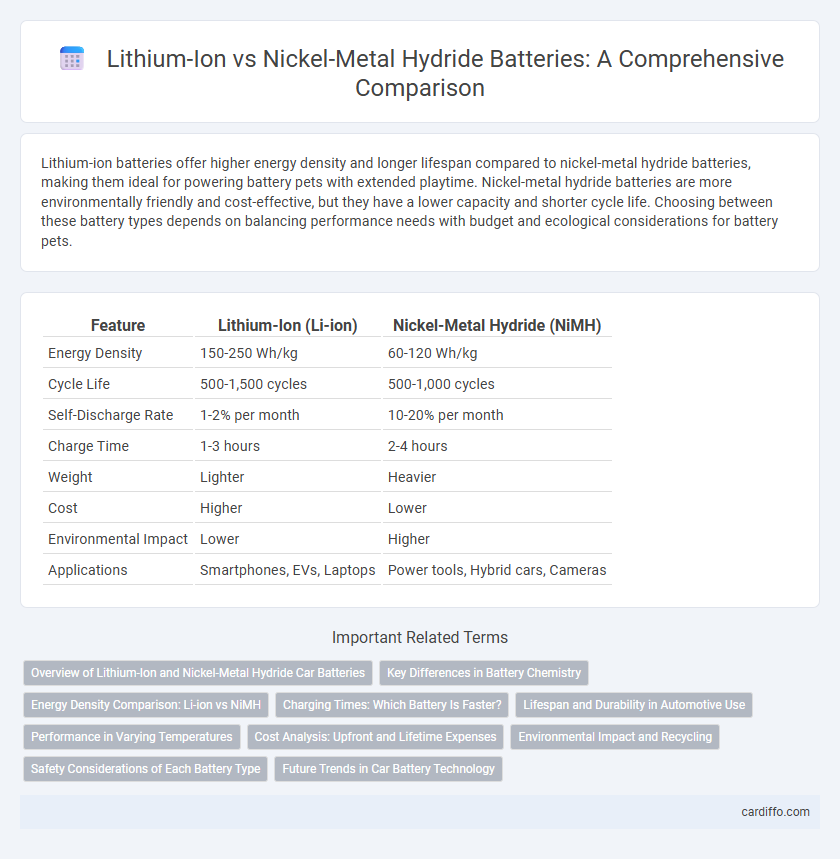Lithium-ion batteries offer higher energy density and longer lifespan compared to nickel-metal hydride batteries, making them ideal for powering battery pets with extended playtime. Nickel-metal hydride batteries are more environmentally friendly and cost-effective, but they have a lower capacity and shorter cycle life. Choosing between these battery types depends on balancing performance needs with budget and ecological considerations for battery pets.
Table of Comparison
| Feature | Lithium-Ion (Li-ion) | Nickel-Metal Hydride (NiMH) |
|---|---|---|
| Energy Density | 150-250 Wh/kg | 60-120 Wh/kg |
| Cycle Life | 500-1,500 cycles | 500-1,000 cycles |
| Self-Discharge Rate | 1-2% per month | 10-20% per month |
| Charge Time | 1-3 hours | 2-4 hours |
| Weight | Lighter | Heavier |
| Cost | Higher | Lower |
| Environmental Impact | Lower | Higher |
| Applications | Smartphones, EVs, Laptops | Power tools, Hybrid cars, Cameras |
Overview of Lithium-Ion and Nickel-Metal Hydride Car Batteries
Lithium-ion car batteries offer higher energy density and longer lifespan compared to nickel-metal hydride (NiMH) batteries, making them a preferred choice for electric and hybrid vehicles. NiMH batteries provide reliable performance with better thermal stability and lower production costs, often found in older hybrid models. The choice between lithium-ion and NiMH affects vehicle range, weight, and charging efficiency, crucial factors for automotive manufacturers and consumers.
Key Differences in Battery Chemistry
Lithium-ion batteries utilize a lithium cobalt oxide or lithium iron phosphate cathode and a graphite anode, offering higher energy density and longer cycle life compared to nickel-metal hydride (NiMH) batteries, which use a hydrogen-absorbing alloy anode and a nickel oxyhydroxide cathode. The lithium-ion chemistry enables lower self-discharge rates and lighter weight, while NiMH batteries typically provide better thermal stability and are less sensitive to overcharging. These fundamental chemical differences influence performance metrics such as voltage output, capacity retention, and charging efficiency across various applications.
Energy Density Comparison: Li-ion vs NiMH
Lithium-ion batteries offer significantly higher energy density compared to nickel-metal hydride (NiMH) batteries, typically ranging from 150 to 250 Wh/kg versus NiMH's 60 to 120 Wh/kg. This higher energy density enables lithium-ion cells to store more energy in the same weight and volume, making them ideal for portable electronics and electric vehicles. The superior energy density of lithium-ion batteries also contributes to longer battery life and improved performance over NiMH counterparts.
Charging Times: Which Battery Is Faster?
Lithium-ion batteries generally charge significantly faster than nickel-metal hydride (NiMH) batteries due to their higher energy density and advanced chemistry, allowing rapid energy absorption and efficient voltage regulation. NiMH batteries typically require longer charging times, often two to three times that of lithium-ion, since their internal chemistry limits charge rates to prevent overheating. Fast charging capabilities in lithium-ion technology make it the preferred choice for applications needing quick turnaround, such as smartphones and electric vehicles.
Lifespan and Durability in Automotive Use
Lithium-ion batteries typically offer a longer lifespan, with 1,000 to 2,000 full charge cycles compared to nickel-metal hydride's 500 to 1,000 cycles, making them more durable for automotive applications. Lithium-ion cells exhibit better energy density and lower self-discharge rates, contributing to sustained performance and extended durability in electric vehicles. Nickel-metal hydride batteries, while more resistant to overcharging and thermal stress, generally suffer faster capacity degradation under frequent deep discharge conditions common in automotive use.
Performance in Varying Temperatures
Lithium-ion batteries maintain higher energy density and efficiency in both high and low temperature conditions compared to nickel-metal hydride (NiMH) batteries, which suffer from significant capacity loss and reduced cycle life in extreme temperatures. The electrochemical stability of lithium-ion cells allows for better charge retention and faster recharge rates when exposed to cold environments, whereas NiMH batteries experience voltage drops and slower charging. Thermal management requirements for lithium-ion cells are more critical but result in superior overall performance across temperature variations.
Cost Analysis: Upfront and Lifetime Expenses
Lithium-ion batteries typically have higher upfront costs compared to nickel-metal hydride (NiMH) batteries due to advanced materials and manufacturing processes. Over the lifetime, lithium-ion batteries offer greater energy density and longer cycle life, which reduces replacement frequency and overall expenses. NiMH batteries may incur lower initial costs but often require more frequent replacements, increasing total ownership costs in long-term applications.
Environmental Impact and Recycling
Lithium-ion batteries offer higher energy density and longer lifespan but pose greater environmental risks due to toxic electrolyte leakage and complex recycling processes. Nickel-metal hydride batteries contain fewer hazardous materials, making recycling simpler and less harmful, though they have lower energy efficiency and shorter cycle life. Both battery types require improved recycling technologies to minimize environmental pollution and enhance material recovery.
Safety Considerations of Each Battery Type
Lithium-ion batteries offer higher energy density but require advanced safety mechanisms to prevent overheating, thermal runaway, and potential fires due to their volatile electrolyte. Nickel-metal hydride (NiMH) batteries exhibit greater thermal stability, reducing risks of overheating and leakage, making them safer for various consumer applications. Proper battery management systems (BMS) enhance safety in lithium-ion cells, while NiMH's inherent chemistry provides robustness under high temperatures and physical abuse.
Future Trends in Car Battery Technology
Lithium-ion batteries dominate the automotive industry with higher energy density and longer lifespan, driving advancements in electric vehicle range and performance. Nickel-metal hydride (NiMH) batteries, though less energy-dense, continue to be utilized in hybrid cars for their cost-effectiveness and thermal stability. Future trends emphasize solid-state lithium-ion technology and enhanced battery management systems to boost safety, charging speed, and energy efficiency.
Lithium-Ion vs Nickel-Metal Hydride Infographic

 cardiffo.com
cardiffo.com